By 2000, Pixar was doing well enough that Steve Jobs finally—finally—agreed to let the company move from its then-shoddy offices in a questionable neighborhood to a brand new production facility. Taking advice from old Disney hands, who remembered the way that an earlier change in production facilities had led to less communication and creativity between artists, Pixar created a large, open space that would, the company hoped, encourage conversation and collaboration. And just in time—Pixar had new projects in the works that presented new technical challenges, including animating individual strands of fur and creating a new underwater world. No longer content with studying fantastic parts of the regular world, Pixar was now ready to create an entirely new world of its own, inhabited by monsters. Friendly monsters, at that.
If the studio could manage the fur.
Pixar’s Pete Docter initially pitched the concept of a monster movie back in 1994, as part of a general pitch session intended to come up with potential ideas for the studio’s next three promised films for Disney. As Docter later explained, he spent his childhood convinced that yes, yes, monsters really did live in his closet—a common childhood fear (though in my case, those monsters were under the bed, not in a closet, and don’t try to tell me that the monsters weren’t there because THEY TOTALLY WERE). The concept of monsters in the closet (or under the bed) just waiting to come out and attack small children seemed a natural follow-up to the concept of Toy Story, where toys came to life. But although John Lasseter embraced the idea with enthusiasm, he decided—for the first time in Pixar history—to step away from the project, leaving the monster film in the hands of Pete Docter, allowing Lasseter to focus on overseeing all of Pixar—not to mention the production nightmare of Toy Story 2.
Docter spent the next two years tinkering with the story. His initial concept—that of a 30 year man still tormented by the monsters in his closet—was eventually tossed out in favor of a tale that would instead focus on a growing relationship between a small child and a monster—and on the monster’s world, a world filled with mostly friendly monsters who shared several human characteristics, such as regular jobs and a need for something to keep their appliances on. The new focus would allow Pixar to explore an entirely new world, a world which, bonus, offered the potential of a new toy line of cute and cushy monsters. It would be a world that would both echo our own while also drawing power from it.
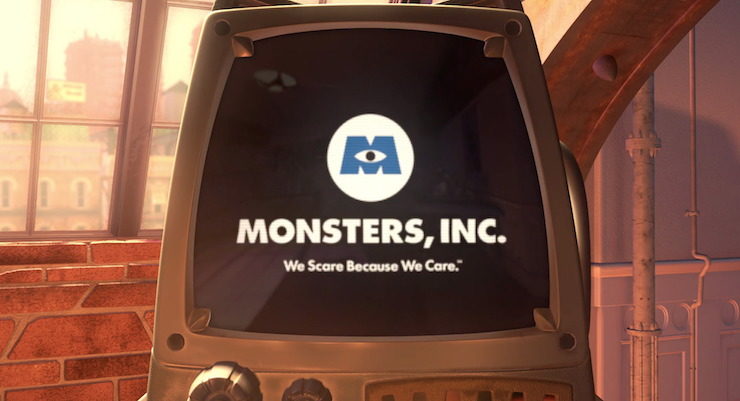
The concept of friendly monsters dates back to at least ancient times, with later fairy tales offering a range of monsters from evil to friendly to (in the case of Beauty and the Beast) potential marriage partners. More recently, Sesame Street had popularized the idea of friendly monsters living on the same street as real humans, willing to help small children learn math, the alphabet, and bits of Spanish. But an animated film exploring an entire world of monsters—many with fur—was new.
Monsters, Inc. was not, of course, the first film to showcase computer animated, realistic looking, moving fur—that credit belongs to the talking animals of the 1995 Babe, who required significant CGI and fur work, winning the film an Oscar for Best Special Effects. But it was the first computer animated/CGI project to require quite so much fur—2,320,413 separate pieces of hair on Sulley, one of the two main monsters of the film. (Not at all incidentally, this is why Mike and Randall, the other two most prominent monsters in the film, have no hair or fur whatsoever.) Pixar animators not only had to make all of this fur move, but they had to account for the way that hair can cast shadows on other hairs. And they had to finish all of this in a more or less reasonable time period, which, the way Disney saw it, meant by late 2001, no ifs, ands or buts—even if, over at the main Disney studios, Disney animators were struggling to keep up with their own deadlines.
To solve the technical problem, Pixar turned to a technical solution: more computer processors. As it was, Toy Story 2 had needed 1400 processors. Monsters, Inc. needed 3500. It was enough—just barely enough—to allow animators to create colorful, realistic looking fur and a final elaborate chase scene and, for good measure, to add something that the first three Pixar films didn’t have: a T-shirt that wrinkled as its wearer moved. Pixar animators were thrilled. How much of this was appreciated by audiences remains an open question, but Monsters, Inc. did represent a significant step forward in computer animation.
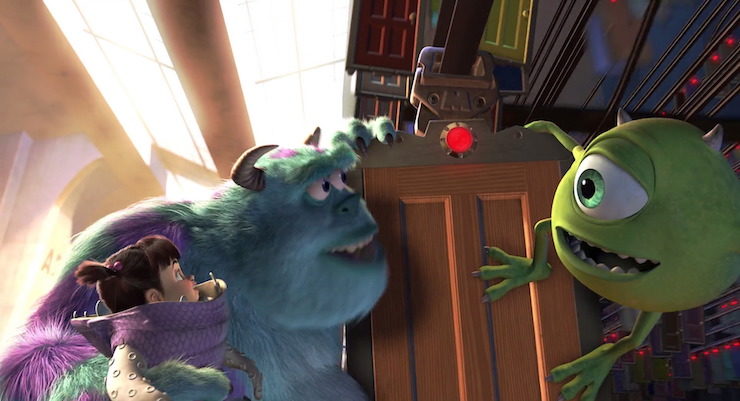
Meanwhile, following the success of booking celebrity voices for the two Toy Story films and A Bug’s Life, Pixar hired comedians John Goodman and Billy Crystal to play the main two characters, Sulley and Mike, and Steve Buscemi to play the conniving Randall, along with a number of other famous voices now eager to work on a Pixar film.
For Boo, the toddler, Pixar turned from the usual animation practice of having an adult voice childlike sounds, and instead, found an actual child of about that age, Mary Gibbs, daughter of story artist Rob Gibbs. Mary Gibbs, then three, was just a touch too young to read a script, so Pixar sound engineers simply followed the child with a microphone, catching the appropriate sounds and matching them to the animation, until screams were necessary, at which point, animators encouraged her to scream. (There’s an adorable picture of her and John Goodman at the film premiere floating around the internet, and a rather less adorable picture of Pixar staff trying to get the small child to scream on cue.) Mary Gibbs, I should note, did survive the experience, continuing on from this to voice other children’s roles for Pixar before choosing a less screaming life as a yoga instructor.
If, with the exception of toddler Boo, Pixar stayed with their usual method of hiring celebrity voices, they did try something else new for this film: assigning each character a specific lead animator—something that had been Disney policy since Snow White and the Seven Dwarfs, but something that Pixar had previously avoided in favor of having lead animators focus on specific scenes. It was a method that Pixar would continue to toy with in future films: for this specific film, the process helped lead animator John Kahrs figure out how to make a massive figure like Sulley move quickly—something else relatively new to animation.
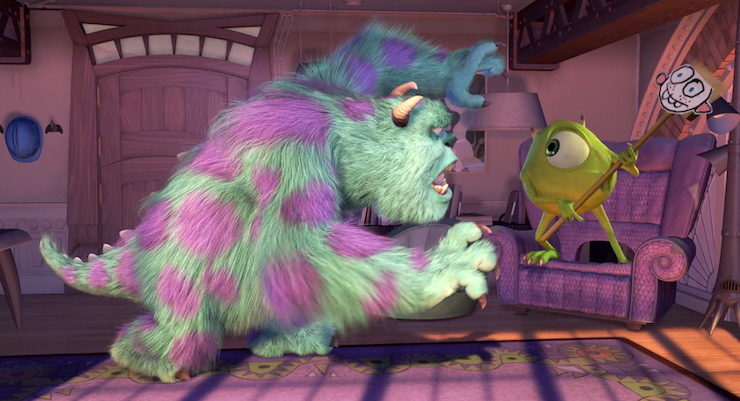
After all this—a shift in production facilities, new computers, following around a small child, and a different approach to animating characters—is the film any good?
Well, it’s definitely cute.
Monsters, Inc. tells the story of Sulley and Mike, who work together with other monsters to collect screams from small children to power up their world. As their company motto states, “We scare because we care!” Alas the screams—and thus the power—are getting harder and harder to get; as the monsters note: “Kids these days. They just don’t get scared the way they used to.” (To be fair, this is in part because kids these days are getting to see fun stuff like Monsters, Inc. instead of terrifying stuff like Dumbo on the big screen, but I digress.)
Exactly how all this works is an excellent question, and I also can’t help wondering what the monsters did with the screams of small children before they industrialized their world and needed to power up a lot of lamps: did they use those screams to start fires? Power windmills? Not that anyone in the monster world has time to answer this, since—GASP—a small human child (eventually named Boo by the monsters) has entered the monster world, threatening to doom every monster there. If Sully and Mike can’t return the kid to her own world, their world may be doomed—or at the very least, their jobs are, which is just as serious. And they might get exiled.
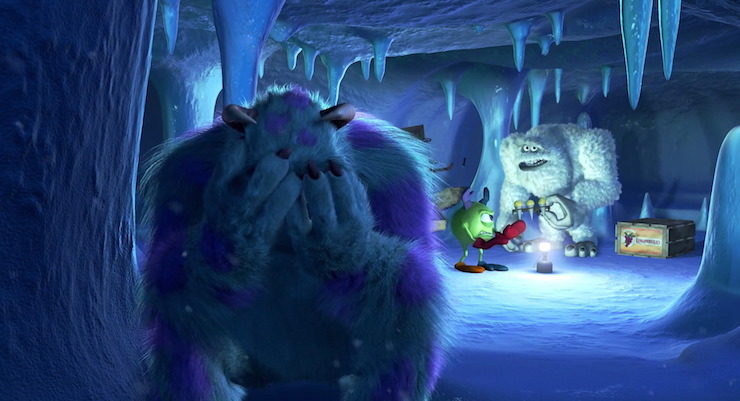
The rest of the film focuses on their various hijinks, as well as their discovery that their world can be powered more efficiently by children’s laughter, instead of their screams—a discovery that works both to save the monsters from having to live without power (as a thorough urbanite, I gasp) and to reassure the smaller members of the audience that no, monsters aren’t really out to get them. Well, not now, anyway.
It’s all cute, often funny, and yet, at the end, somewhat unsatisfying. This is partly, of course, because it’s a Pixar film, but one that lacks the emotional depth of many of the other Pixar films, and partly because, despite the rich possibilities offered by a world inhabited by monsters, Monsters, Inc. never really tries to explore any of this. The monster world is just a light parody of our own, offering the same things: books, cars, fine restaurants that take months to get a reservation unless you’re a celebrity, paperwork, and so on. The monsters look different than humans do, but that’s it. Amusing, certainly, but almost a waste of the concept. To his credit, John Lasseter would later insist that Zootopia, essentially another parody of our world, make at least an attempt at figuring out how a world inhabited by talking animals would differ from our world, but in Monsters, Inc. it all feels rather like a lost opportunity—especially after the explorations of the worlds of toys and bugs in the previous Pixar films.
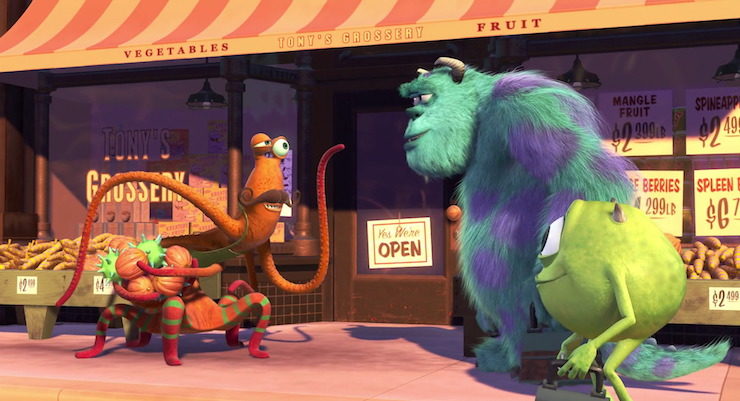
Beyond this, Monsters, Inc. suffers from a more fundamental storytelling problem: that although the background and the world of Monsters, Inc. change, the characters themselves barely do. Sully is still a tall, goodnatured monster; Mike is still a short, neurotic monster. They continue to work as partners, only changing who gets to enter the bedrooms of small children.
Only Boo gets any real development—shifting from a babbling little girl terrified of monsters in her closet to a babbling little girl unafraid of monsters in her closet—even missing one of them very very much. But throughout the film, Boo is more of an object than a character, someone to be either used or rescued. So this development, while welcome, does little to add any depth to the film.
On the other hand, Monsters, Inc. does give us Roz, the nightmarish bureaucratic monster who manages to not only terrorize her staff, but also—with the accidental help of Sully and Mike—shut down business corruption and stop an attempt to torture a small child.
So the film has compensations.
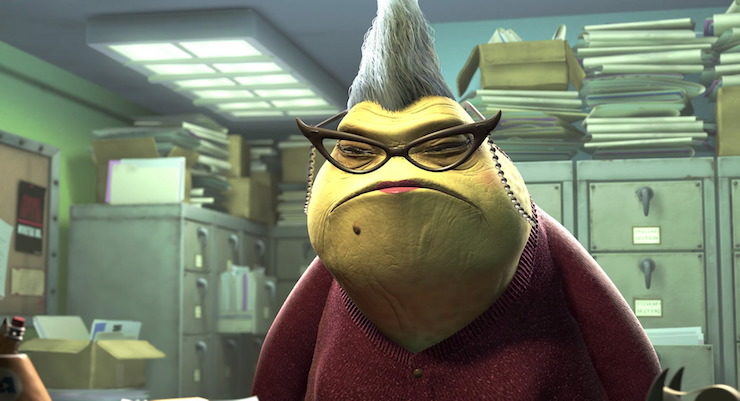
Pixar had learned something from the frantic last minute overwork for Toy Story 2, which meant less of a scramble to get Monsters, Inc. to Disney by their deadline. For a terrifying moment, however, it seemed that all of Pixar’s work would be wasted, as Disney and Pixar found themselves facing a preliminary injunction against releasing Monsters, Inc.—with the hearing scheduled for November 1, 2001, just one day before the film’s planned theatrical release.
The timing was accidental: the injunction had been sought by songwriter Lori Madrid months earlier, and just happened to land on the pre-release date thanks to a heavy court caseload. Disney attorneys and Pixar witnesses explained, in depth, just how much money had been spent in marketing the film already—$3.5 million just on a premiere and special screenings, not including trailers, posters and a huge publicity blitz. Failing to release the film on its release date would, Disney executives argued, create a snowball effect, not just on the initial box office receipts but on later DVD sales and ancillary revenue. The argument convinced the judge, who dismissed the injunction on the basis that it would cause far too much financial harm to Disney. (Not to mention the potential emotional harm to parents who had promised to bring small children to the film.) A year later, the judge dismissed the suit, saying the film and Lori Madrid’s poem did not have that much in common—even if Madrid had shopped her poem/story to Chronicle Books in 1999, which had later printed a Monsters, Inc. art book in 2001.

(Note: although Chronicle Books had published Star Wars books under a licensing agreement with Lucasfilm, the prior owners of Pixar, Disney and Pixar attorneys note that by 1999, Monsters, Inc. was already well into development; in addition, Pixar and Chronicle Books only began discussing the art book in 2000, after Monsters, Inc. was in production.)
A second copyright infringement suit was launched against Pixar, Disney and Chronicle Books in 2002 by artist Stanley Miller, alleging that the character designs for Sulley and Mike were based on characters he had developed for a potential animated film—and that Pixar’s art department had seen his cartoons. (Pixar’s art department did have at least some of Miller’s cartoons; whether they had seen the specific cartoons alleged to have inspired Sulley and Mike was another question.) In this case, the judge did not dismiss the suit; Pixar and Disney settled for an undisclosed amount.
Despite the near-injunction and the financial settlement, Monsters, Inc. was another financial success for both Disney and Pixar. The film garnered mostly positive reviews, and eventually brought in $577.4 million at the box office—at the time, below only The Lion King, and—perhaps even more importantly from the point of view of a still-irritated John Lasseter—well above the $484.4 million brought in by rival Shrek that same year. (Shrek took its revenge the following year, when it won the Academy Award for Best Animated Picture, leaving Monsters, Inc. clutching the Oscar for Best Song.)
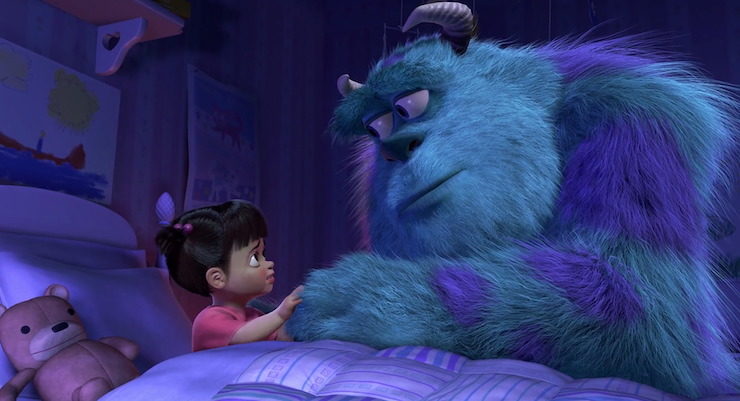
Better prepared this time, Disney also released a line of merchandise, including toys, clothing, mugs (some of which, I must say, were/are kinda creepy looking) and video games. Sully and Mike made appearances at the theme parks, both in Character Meet and Greets and Parades. Three Disney parks created Monsters, Inc. attractions: Mike & Sulley To the Rescue at Disney California Adventure; Monsters, Inc. Ride & Go Seek at Tokyo Disneyland; and Monsters, Inc. Laugh Track at the Magic Kingdom, which incidentally ended up employing one of my friends as a comedy monster.
It all was enough to make Disney quite excited about the potential of another Monsters film—if, admittedly, one to be made by their in-house computer animation department, not Pixar, a company they were on increasingly poor terms with. But before that, Disney and Pixar had a few more contracted films to produce and distribute together. Including a film about a little clownfish.
Finding Nemo, coming up next month.
Mari Ness lives in central Florida.










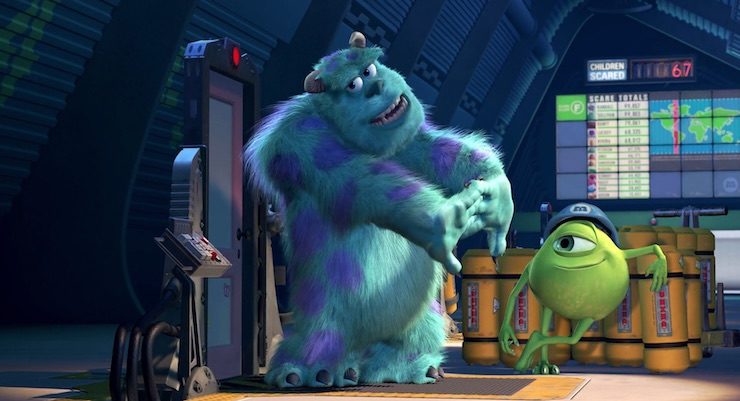
I have to disagree with you on this particular point, and your more general impression that the film lacks the emotional depth of some other Pixar movies. Sully and Mike’s core personalities may not change very much, but their priorities and relationships certainly have. Sully, while generally goodnatured, begins the film as a competitive (and slightly arrogant) monster who doesn’t even think to question the system he’s part of; after he meets Boo (and very specifically after he sees how much his job frightens her, and makes him indistinguishable from the “bad” monster, Randall), Sully realizes that just maybe exploiting kids’ fear is morally wrong, even if it does power the city. The plot convenience of laughter being a powerful replacement I’m sure helps convince the rest of Monsteropolis to convert, but I think Sully at least would have fought for a new way, regardless. And switching places with Mike at the end isn’t just a simple reversal; it shows that Sully has come to respect Mike as more than simply a sidekick to his own glory. Plus, when Sully runs the revamped power plant, the “Laughfloor” doesn’t even seem to foster the same sense of competition as the old system; the “Top Scarer” ranking board has been replaced with a Joke of the Day. Mike might not have quite the same emotional journey, but even he manages to unlearn his prejudices both about human children and the true measure of a monster; where he once idolized Sully and the other scarers, now he can count himself their equal.
I’m going to have to agree with @TorSarah on this one, especially in the case of Sully, as #1 points out. And to a lesser extent, in the case of both Sully and Mike. This starts like a lot of buddy movies – two friends who are great together and everything works in their lives, for the most part. But with the addition of Boo, and particularly Boo’s budding friendship with Sully, the friendship dynamic has to change. Boo threatens Mike a lot – at first because of his fear of the deadly child (being sneezed on must have been terrifying), then the threat to their jobs (Mike’s line about her prescence destroying the company), then the threat to their societal status (banishment), and finally to the threat of their friendship (when Mike tells Sully he’s on his own, alone).
Granted the change in their friendship isn’t polar opposite by the end. Mike and Sully start as best friends, and they end as best friends. But the depth and nature of that friendship is very different by the time the film ends. I would argue that this is a more complex way to have story move. Dan Wells talked about this in his 7-point Story Structure YouTube series when he compares Batman/Bruce Wayne’s change in Batman Begins vs. The Dark Knight. Mike and Sully’s change isn’t from weakness to strength, but from strength to a different strength.
I don’t blame you for the under the bed thing. As a child, I usually kept my closet door open at night, so that was basically the only place for the monsters to come and get me.
Much like other Pixar films, there was a 1989 film that, I’m sure, provided some inspiration to this film (or at least bore striking similarities); a little piece starring Fred Savage and Howie Mandel called Little Monsters, which deals heavily with the under the bed approach to monsters. In this film (for those of you who haven’t seen this one) deals with a blue monster bringing a child into his monster world, and chaos ensues.
Worth noting is that Stanley Miller is probably better known as Stanley Mouse, artist responsible for certain Grateful Dead imagery, and the allegedly infringing work of Lori Madrid’s is a poem called “There’s a Boy in my Closet,” which she later adapted into a stage play.
Finally, I like to pretend the Disney Junior show Henry Hugglemonster (my daughter watches it; right… that’s it) takes place in the same universe, but in the more rural areas of the Monster world.
I remember, as a 16-year-old sitting in the theater, marveling at the scene where they’re in the Himalayas, because it was at that point I noticed (thanks to the constant wind whipping about) how much detail went into all of Sully’s individual hairs.
Myself, I found Monsters, Inc to be totally satisfying. And that chase scene though the storage area where thousands of doors hung from metal tracks was a marvel to behold.
There was a fully packed auditorium of Apple developers at WWDC watching the Pixar animators talk about Sully’s fur – we were definitely impressed.
I think that Mike and Sulley did actually change, and this change included their perception of human children as more than just deadly animals. Their friendship was also tested and dynamic throughout the movie, including the part when they argue and part ways and when Mike apologizes in his roundabout way. And at the end of the movie Mike actually puts countless hours into restoring Boo’s door for his friend’s benefit: he goes from fearing this child as a deadly creature, to seeing her as something that could ruin his livelihood, to finally growing to accept her.
And of course their change in perception about human children mirrors the larger scale revolution in the monster culture (or at least the monsters, inc factory) that laughs are better than screams. So it’s not just them changing but their culture. Although what monster society as a whole thinks of this discovery, whether there are conservative factions that resist this change for instance, is up in the air.
Anyway, to me this is the funniest of Pixar’s movies and I don’t think a tearjerker scene is necessary to make one of their movies properly emotional. As a kid, it brought a lot of laughs and shocks, particularly with the twist ending, which at the time wasn’t as overdone as it is now (the climax of Zootopia was pretty much the same as this one).
Aw man, I love this movie. I saw it in theaters when I was about 16 and now it’s one of the ones I still enjoy enough that I don’t mind my toddler demanding it once a week! (Right now it’s all about Monsters Inc, Toy Story 2, and the original Star Wars trilogy, hah). The end makes me tear up, but I’m glad it’s not more sad than that. In comparison, I absolutely can’t watch Toy Story 3 because it’s hugely depressing, and while the nuance might go over my kid’s head, the real test of a kid’s movie for me is finding that middle ground of something they love that doesn’t become insufferable for adults on repeat. On a related note, I refuse to buy Finding Nemo, nobody tell my kid about the fish movie please.
Surely the opposite would be true? Children who had never seen anything frightening wouldn’t be emotionally prepared for real monsters actively trying to frighten them and so would be easy to scare.
I’m with most of the other commentators in thinking there is a fair bit of emotional depth here. Sully’s journey echoes a lot of characters in comedies – the care free bachelor who suddenly finds family responsibility thrust upon him and learns there’s something missing in his life. (think “Three Men and a Baby”). It’s presented slightly differently because Sully has no romantic partner and he returns Boo to her own world and parents at the end. But, I think it’s significant that he takes on the role of Company Director and seems to be carrying out that role in a more nurturing way than Waternoose.
Bonus points for one of the all-time great musical numbers:
https://www.youtube.com/watch?v=tqaHBfBSSuc
This is in my top 5 Pixar movies. I love it. Agreed that there is definitely character development in the two leads.
Side note: I’m still waiting for the sequel/crossover where Boo is college roommates with Lilo and her weird dog.
@Jason_UmmaMacabre – YES! DISNEY, MAKE THIS HAPPEN! That would be awesome.
@Jason_UmmaMacabre — I find your ideas intriguing and I wish to subscribe to your newsletter.
@12 & @13, I wish I could take credit for it. I read this idea on the internet a couple years ago and loved it.
I agree with the many others who have pointed out the character development and relationship maturation between Sully and Mike. Anyway – my kids love these movies and Monsters U. In fact, for the past 3 years in a row my son has requested Monsters themed cakes that my husband bakes for him (Sully, Mike and Art, respectively).
That said I have a strange aversion to this movie, and it’s due to the idea of this little kid being missing from her room for several days – I have to believe time just passes differently in our universes because otherwise what on earth were the parents doing? I also have a hard time with all the near misses with Boo (almost falling from huge heights, getting crushed in a trash compactor, etc). It’s the kind of thing that after I had kids (and PPA) I have a hard time watching without overthinking.
All that said, I really LOVED Monsters University so I will be excited to get to that one.
Open Plan offices, the nightmare workplace of the introverted.
I loved the idea of this story — child befriending and ‘reforming’ maligned monsters — but was meh on the execution. I do respect it as a major linchpin of the Pixar Theory.
If I had watched it after becoming obsessed with Recess, however, I would have been rather more affected by the fact that its villain happened to be named Randall.
When a friend and I were kids, her house had what we called “the laughing closet.” Everything we said within it seemed hilarious, and we’d sit in it and talk and laugh our heads off. Maybe those monsters somehow rigged it to induce our laughter, which they harvested. I like that thought.
If kids were unaccustomed to scary animated movies when Monsters, Inc. debuted, it was only because Pixar hadn’t yet made WALL-E and Toy Story 3.
Finding Nemo Finding Nemo Finding Nemo…*wriggles with impatience*
@15, if it helps – it all happens in one night and one day. Sulley ends up with Boo after work, pretty late it seems, and the rest of the action at the factory happens the next day. Even the exile to the Himalayas doesn’t last very long – how long does it take to have an argument and then slide down a mountain at dangerous speeds, after all?